
 Copyright © Michael Richmond.
This work is licensed under a Creative Commons License.
Copyright © Michael Richmond.
This work is licensed under a Creative Commons License.
Low-mass stars lead a relatively peaceful life in their old age: although some may gently blow off their outer envelopes to form beautiful planetary nebulae, the bulk of the star always remains intact. Eventually, the star ends up as a dense white dwarf, which slowly cools and dims and cools and dims.
High-mass stars, on the other hand, experience a short but exciting life, which ends with a bang, not a whimper. The key is the core of the star and the nuclear reactions which occur therein. Let's take a look....
You may recall that a star like our Sun will eventually run through the hydrogen in its core, creating helium; then fuse the helium into carbon and oxygen:

The gravitational forces on the cores of high-mass stars drive the pressure and temperature high enough that additional fusion reactions take place: carbon and oxygen fusing with lighter nuclei to form neon:

Then reactions in which neon turns into silicon:

And finally silicon turning into iron:
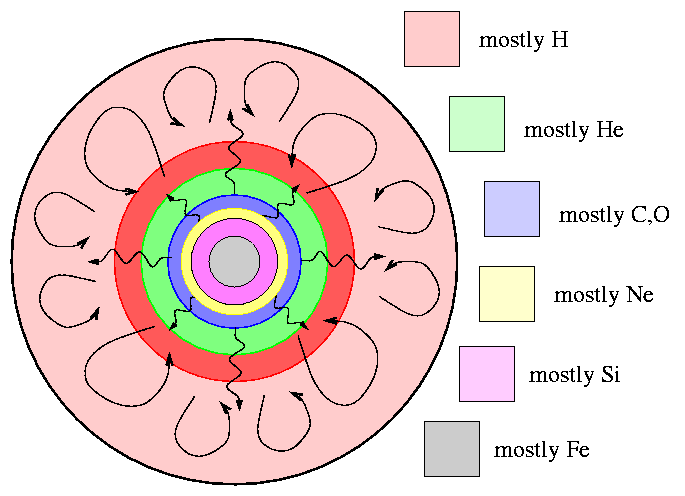
But the timescales for these stages become shorter and shorter, partly because there's a smaller initial amount of each fuel, and partly because the reactions take place at higher and higher temperatures and so go more and more quickly. The final stages go very quickly indeed:
fuel lifetime (for 20 solar-mass star) -------------------------------------------------- H 10,000,000 years He 1,000,000 years C 300 years Ne 0.5 years Si 0.01 years --------------------------------------------------
You can get a qualitative (but not quantitative) feel for the rapidity of the late stages by watching this animated GIF (which gives the final stages way, way too much time).
When light elements -- such as hydrogen -- fuse together to form heavier elements -- such as helium -- the resulting nucleus has less mass than the original components. The "missing" mass turns into energy according to Einstein's equation
2
E = m c
But it turns out that this process is most efficient for the very lightest elements. As one fuses heavier and heavier nuclei, the fractional payoff in energy becomes smaller and smaller. One way to show this is with the curve of binding energy .
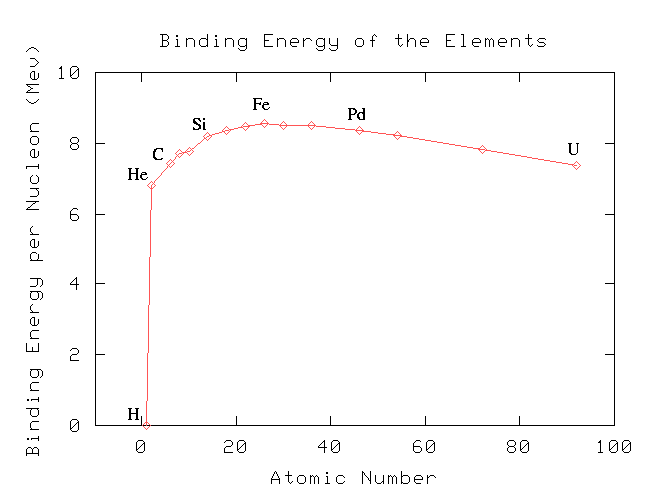
"Binding energy" measures the difference between the mass of a nucleus and the mass of the individual protons and neutrons which make it up. The larger the binding energy, the more mass disappears when you fuse elements together. If you fuse element A into element B, you get an amount of energy which depends on the difference
energy released = (binding energy of B) - (binding energy of A)So, for example,
Q: What happens when you fuse iron into heavier elements?
The answer is -- you LOSE energy! Instead of generating energy and increasing the temperature of a stellar core, fusion reactions involving iron will REMOVE energy, and drop the temperature.
So what happens when a massive star has built up a large core of iron? As the iron core is pressed in on itself, any reactions which take place don't release energy -- they "suck away" energy, decreasing the temperature of the core.
In a fraction of a second, the iron-rich core of the star collapses, from a sphere roughly the size of the Earth (radius 6000 km) to a ball of radius only 50 kilometers or so. As the core shrinks, the protons and electrons in it are crushed together to form neutrons. Neutrons are peculiar particles: they resist being pressed together closely (you can look up "neutron degeneracy pressure" sometime if you like). The core collapse halts when the pressure of the "neutron gas" reaches a critical level.
During the collapse, the reactions which turn protons and electrons into neutrons also release neutrinos. The core collapse of a massive star can produce a huge pulse of neutrinos, containing more energy in a single second than the Sun will radiate in a million years!
On 1987 February 23, at 07:36 UT, two neutrino detectors were in action: one in a salt mine near Cleveland, Ohio, and the other in Japan. Each detected a brief burst of neutrinos:

.... but no one noticed this immediately, because the bursts were small and didn't stand out greatly above the ordinary background noise.
Several hours later, astronomers in the southern hemisphere noticed something different about the Large Magellanic Cloud, a satellite of our Milky Way that looks sort of like a glowing, um, cloud, in the sky:
Here's a closeup:
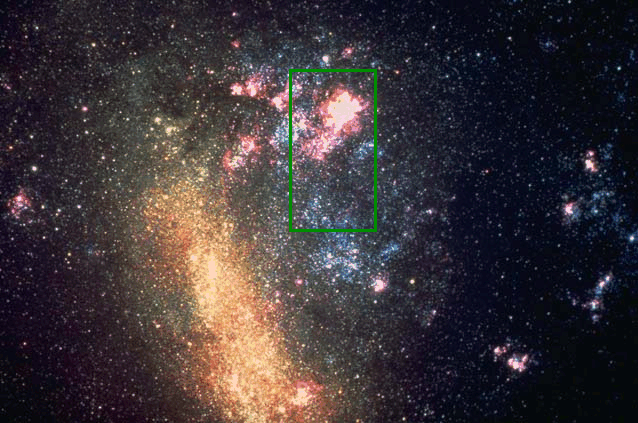
Image credit and copyright:
AURA
NOAO
NSF
The region inside the box is a big, bright HII region called the Tarantula Nebula. Normally, it looks something like the picture at left below ... But on this night, February 23, 1987, several of the astronomers noticed that it was different somehow (as shown at right):
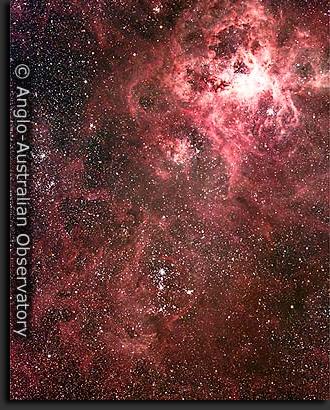
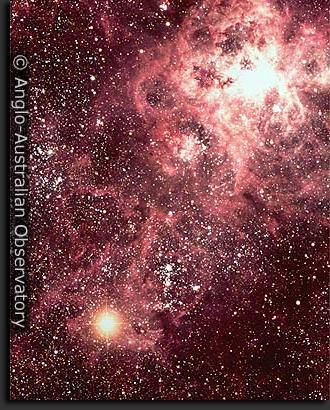
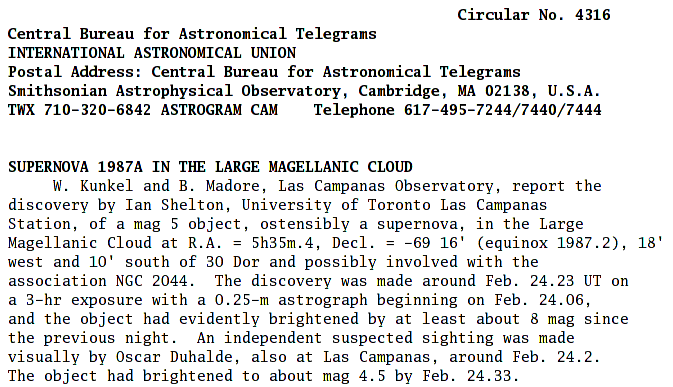
It was the visible light from the explosion finally reaching the Earth. It took several hours for the shock wave from the center of the star to move outwards through the star's atmosphere and reach the photosphere (the "surface"), giving rise at last to visible light.
We believe now that this event, called Supernova 1987A in the Large Magellanic Cloud, occurred when the core of a massive star collapsed suddenly. Over the next minute or so, the inner layers of the star fell onto the super-dense core. The collision of these layers with the core created a shock wave which shoots back outwards at thousands of kilometers per second. The shock wave ripped through the outer layers of the star, heating them up to millions of degrees and shoving them outwards violently. Several hours after the core collapsed, the shock wave broke the surface; the outer layers suddenly exploded and radiated X-rays, ultraviolet and visible light like crazy.
Here are some short movies showing other supernovae exploding in more distant galaxies. Note how bright the supernova is compared to its host galaxy.
SN 1998dh in NGC 7541 (thanks to Tim K.)
SN 1998S in NGC 3877 (thanks to Pedro Re')
For a few weeks, the supernova can outshine an entire galaxy and its hundreds of billions of stars. However, as the expanding shell of gas radiates away its energy, it begins to cool. The supernova gradually fades, dimming to about 1 percent of its peak intensity after three or four months.

As the years pass, the shell of ejected gas becomes cooler and cooler, dimmer and dimmer -- but also larger and larger. In 1993, a supernova exploded in the nearby galaxy M81:
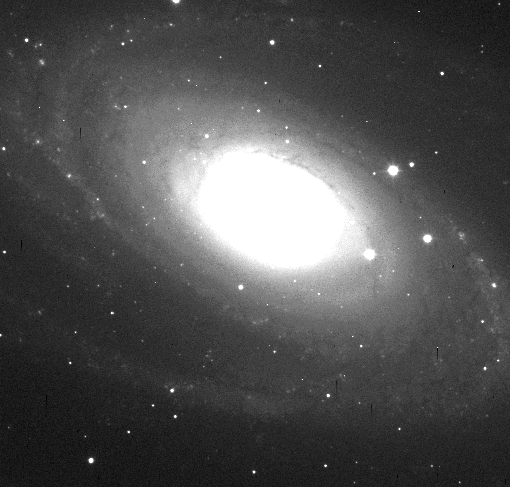
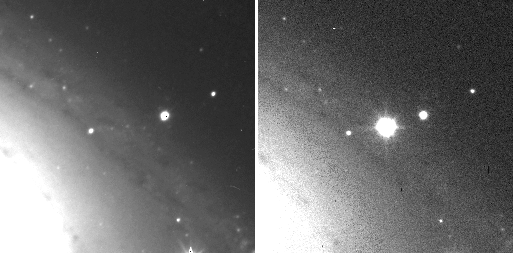
Radio astronomers were able to watch the shell of gas expand with time after it was blown off the star:
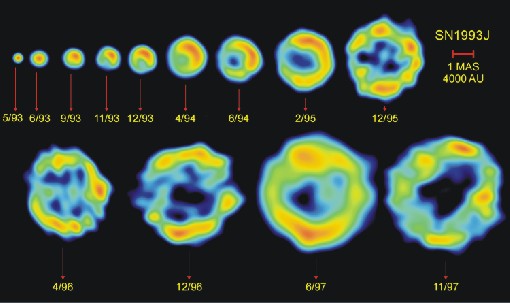
In our own galaxy, we can look at the remnants of a supernova which exploded in the year 1054: the Crab Nebula. Pictures taken in 1973 and 2000 reveal the continuing expansion of the gas.
After tens of thousands of years, the ejected material starts to merge with the general interstellar medium.
It will enrich other clouds with the heavy elements which were once deep inside the stellar interior, elements such as carbon, oxygen, potassium, calcium and iron. The very atoms which make up your body were once blown out into space in a supernova.
 Copyright © Michael Richmond.
This work is licensed under a Creative Commons License.
Copyright © Michael Richmond.
This work is licensed under a Creative Commons License.